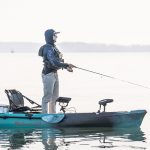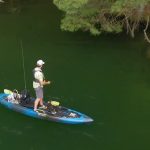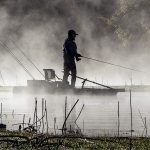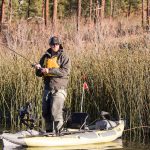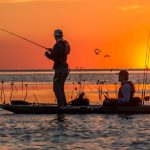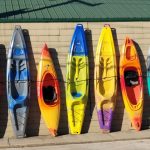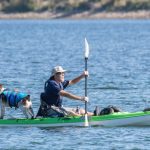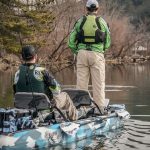As the world of kayak fishing evolves, motorized kayaks are getting wildly popular. We'll discuss the pros and cons of motor powered kayaks and help you pick the best model for your needs!
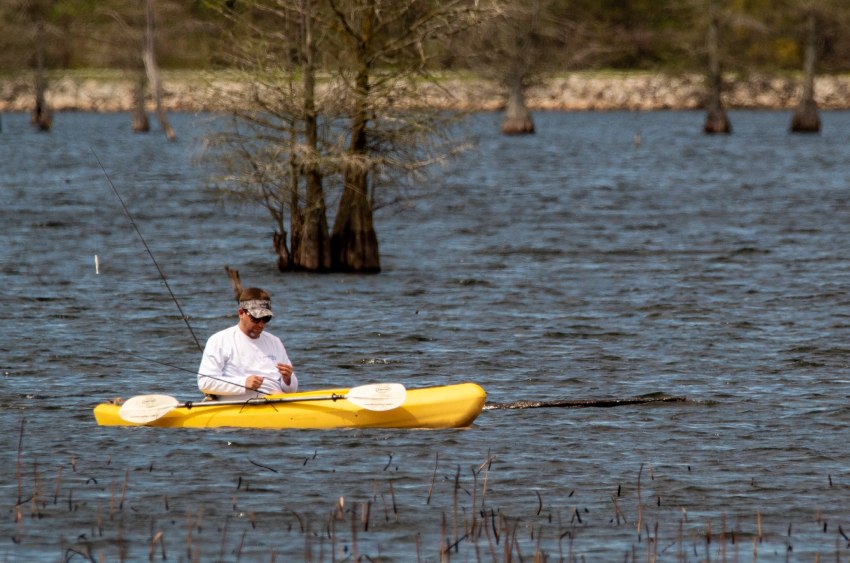
Kayak fishing in wide, slowly moving rivers is not that much different from fishing in lakes. The main difference is that you have to plan your return to the launch site or have somebody pick you up downstream.
But in narrower and faster moving rivers and streams, you need special skills and a more specialized kayak. You should be able to read the water to know where to paddle and where to cast. If you don’t know what you’re doing, things can go bad very quickly.
You also need a kayak that can handle a wide range of conditions that a river might put you in. But how do you choose one?
Here at Paddlingspace.com, we’ve reviewed and analyzed hundreds of fishing kayaks over the years. For this roundup, we’ve picked 11 models that we believe are the best river fishing kayaks on the market in 2023. This comprehensive review will help you find the best kayak for your needs and budget.
As an affiliate of Amazon and other retailers, we may earn a small commission when you buy via our links, at no additional cost to you. Thank you!
Quick Answer: Best River Fishing Kayaks in 2023
- Crescent Ultralite
- Old Town Sportsman 106
- Vibe Yellowfin 100
- Jackson Coosa
- Perception Pescador Pro 10.0
- FeelFree Moken 10 V2
- Bonafide SS107
- Nucanoe Flint
- Advanced Elements StraitEdge Angler
- Wilderness Systems Ride 115
Comparison Table: Best Kayaks for River Fishing
| Model | Specs | Where to Buy |
Crescent UltraLite | Size: 10’2″ x 35″ Weight: 49 lb Capacity: 350 lb | Crescent |
 Old Town Sportsman 106 | Size: 10’6″ x 34.5″ Weight: 73 lb Capacity: 440 lb | Eco Fishing Shop |
Vibe Yellowfin 100 | Size: 10′ x 32″ Weight: 57 lb Capacity: 375 lb | Field & Stream |
Jackson Coosa | Size: 11’2″ x 32″ Weight: 65 lbs Capacity: 350 lb | Eco Fishing Shop |
Perception Pescador Pro 10.0 | Size: 10’6″ x 32″ Weight: 57 lb Capacity: 325 lb | Amazon |
FeelFree Moken 10 V2 | Size: 10′ x 33″ Weight: 68 lb Capacity: 440 lb | Eco Fishing Shop |
Bonafide SS107 | Size: 10’7″ x 34″ Weight: 89 lb Capacity: 425 lb | FishUSA |
Nucanoe Flint | Size: 11’3″ x 33″ Weight: 63 lb Capacity: 375 lb | Eco Fishing Shop |
 Advanced Elements StraitEdge Angler | Size: 9’7″ x 35″ Weight: 41 lb Capacity: 300 lb | Amazon |
Wilderness Systems Ride 115 | Size: 11’6″ x 33″ Weight: 76 lb Capacity: 500 lb | Amazon |
Crescent UltraLite

Length: 10’2” (309.88 cm)
Width: 35” (76.2 cm)
Weight: 49 lb (22.2 kg)
Capacity: 350 lb (158.7 kg)
The Crescent UltraLite is a throw-and-go kayak that’s great for river fishing. This 10’2” (310 cm) kayak is made with a good amount of rocker that translates to high maneuverability along the toughest river rapids. The boat also weighs just 49 pounds (22.2 kg), which means you’ll have no problems launching in steep areas or dragging it over shallow sections of the river.
The cockpit offers a wide open deck that allows you to easily stand and fish without obstruction, which is also good for fly fishing as it can hold excess line. The UltraLite’s seat is very low to the deck, which means you’ll have a better chance of remaining upright when going through rough water.
This kayak offers a total capacity of 350 lbs (158.7 kg), which is enough to hold most boaters and a decent amount of gear. One of the only downsides to the UltraLite is that it has limited dry storage in the form of a sealed bow hatch. However, the kayak does feature bungee cords on the bow and stern that can be used to secure dry bags and any other gear you’ll need to bring along.
Old Town Sportsman 106
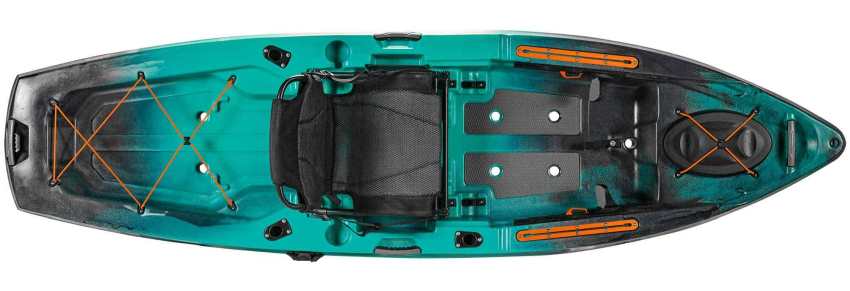
Length: 10’6” (320 cm)
Width: 34.5” (87.6 cm)
Weight: 73 lb (33.1 kg)
Capacity: 440 lb (199.6 kg)
The Old Town Sportsman 106 is a decent river kayak that is short and compact enough to allow you to quickly turn and navigate through rapids while also delivering great stability. The 10’6” (320 cm) boat is just the right length for river use, but this kayak is quite a bit heavier than what most anglers might prefer.
It has a fully-rigged weight of 77 lbs (34.9 kg), which is likely to be hard to handle on steep banks and trudging over shallow rock beds and sand bars. The Sportsman 106’s design does help to make up for any shortcomings it has. This kayak is one that offers exceptional primary stability that is unshakable on mostly calm waters.
The boat does have much less rocker than what you might normally look for in a solid river kayak. It does offer a very comfortable seat that can be adjusted into a high or low position, along with a litany of impressive features.
Vibe Yellowfin 100

Length: 10’ (305 cm)
Width: 32” (81.3 cm)
Weight: 57 lb (25.9 kg)
Capacity: 375 lb (170 kg)
The Vibe Yellowfin 100 is a great blend of comfort and portability that’s right at home on any river. The boat’s compact 10’ (304.8 cm) design features enough rocker to make it nimble when maneuvering through rapids or other obstacles in the water. At just 64 lbs (29 kg) fully-rigged weight, the Yellowfin 100 is just what you look for in a throw-and-go kayak made for rivers.
RELATED: Vibe Kayaks: Full Model Lineup and Reviews
This boat doesn’t have a good location for horizontal rod storage, which will present a challenge on tight streams with low overhanging branches. However, there is ample dry storage in the form of a bow and cockpit dry hatch, as well as bungee cords on the stern well.
The seat is very comfortable and is situated close to the deck to lessen any potential for you to tip over in rough waters. The Yellowfin 100 can hold up to 375 lbs (170 kg) of total capacity and any water that does happen to splash into the cockpit will be quickly drained thanks to the eight scupper holes that are spaced throughout the deck.
Jackson Coosa

Length: 11’2” (335 cm)
Width: 32” (81.3 cm)
Weight: 60 lb (29.5 kg)
Capacity: 350 lb (158.7 kg)
The Jackson Coosa is a heavy-duty kayak that is packed with features and can also be used on relatively calm rivers. The Coosa is made with a shorter 11’2” (340 cm) design that is compact enough to easily travel through rivers and allow you to avoid most obstacles that come your way.
The Coosa is not necessarily a throw-and-go as it weighs 70 lbs (31.7 kg) fully-rigged, but it is light enough to be used along rivers with little trouble. This boat offers 350 lbs (158.7 kg) of total capacity and presents you with more than enough dry storage compartments for valuable gear that you don’t want getting wet.
The Ergo seat is very comfortable and can easily be adjusted into a high or low position depending on your personal preferences. One of the most attractive characteristics of the Jackson Coosa is its outstanding stability that will allow you to stand and fish with no issues. The boat offers higher primary stability, which is best-suited for flat water, but the hull design also delivers enough secondary stability to deal with rough water to a degree.
Perception Pescador Pro 10.0

Length: 10’6” (323 cm)
Width: 32” (81 cm)
Weight: 57 lb (26 kg)
Capacity: 325 lb (147 kg)
The Perception Pescador Pro 10.0 makes a very strong case for being the best overall river fishing kayak on the market today. This 10’6” (323 cm) boat is right at home on any fast-moving river. It’s able to handle most rapids with ease thanks to a decent amount of secondary stability that helps you stay afloat when the water around you is churning.
One of the central features of the Perception Pescador Pro 10.0 is the comfortable seat, which is said to be one of the best in the industry today. The seat sits very low to the deck and can be adjusted to recline as much as you want. The kayak also has slightly less capacity than most others on our list at 325 lbs (147 kg).
It tips the scales at just 57 lbs (26 kg) fully-rigged, which makes it perfect for any challenges you’ll run into in the form of treacherous banks or shallows. One of the only downsides is that it lacks dry storage compartments. However, you’ll find that the Perception Pescador Pro 10.0 offers a bow well cover, as well as bungee cords across the large stern well that are capable of securing any gear you have.
FeelFree Moken 10 V2

Length: 10’ (305 cm)
Width: 33” (83.82 cm)
Weight: 68 lb (30.84 kg)
Capacity: 440 lb (199.6 kg)
The FeelFree Moken 10 V2 might be one of the best value river kayaks of any on our list. This 10’ (304.8 cm) is compact and nimble enough to maneuver through any rapids or other obstacles you encounter on rivers. Despite its short stature, it is somewhat heavier at 68 lbs (30.8 kg), but most anglers should have no problem handling this boat in or out of the water.
This kayak is ideal for hunting and camping as you’ll have no problem loading all your gear thanks to its 440 lbs (200 kg) capacity. You can also adjust the seat to just the height you need and can stand and fish when you want thanks to the hull that’s designed with optimal primary and secondary stability.
The FeelFree Moken 10 V2 offers a dry storage compartment in the cockpit area, along with a bow and stern well area that are both equipped with bungee cords to secure any gear you have. With just the right amount of rocker, it’s easy to see why so many river fishing enthusiasts are raving about this kayak.
Bonafide SS107

Length: 10’7” (322.5 cm)
Width: 34” (86.3 cm)
Weight: 89 lb (40.3 kg)
Capacity: 425 lb (192.7 kg)
Bonafide’s SS107 is another kayak that’s capable of fishing on most rivers or any other type of water. This model is designed to be 10’7” (322.5 cm) and offers an outstanding total capacity of 425 lbs (192.7 kg). This kayak is packed with features that make it appealing to any angler and it’s just what you need to fish along most rivers that feature calm to moderate rapids.
RELATED: Bonafide Kayaks in 2023: Model Lineup and Reviews
One of the few downsides in terms of river fishing with the Bonafide SS107 is that it’s just a bit heavier than what most anglers are looking for. It weighs 84 lbs (38.1 kg) when fully-rigged with seat and all, which will be tough to handle going up and down steep embankments.
The SS107 does offer excellent dry storage options that include a huge oversized hatch on the bow that’s able to store a good amount of gear inside. Bonafide designed the SS107 with a hybrid catamaran style hull that is better-suited for flat water instead of rivers. The boat doesn’t feature enough rocker to accommodate for rough water and you’ll probably find it difficult to navigate through rapids as the hull offers much greater primary stability instead of the necessary secondary hull stability.
Nucanoe Flint

Length: 11’3” (342.9 cm)
Width: 33” (83.8 cm)
Weight: 63 lb (28.5 kg)
Capacity: 375 lb (170 kg)
The Nucanoe Flint is made to be right at home on any river you want to fish. The kayak is 11’3” (343 cm) in length and just 33” (88.8 cm) wide to maneuver through winding rivers. The Flint is relatively lightweight at just 63 lbs (28.5 kg) fully-rigged and should be no problem for most anglers to handle in or out of the water.
This kayak might not have all of the bells and whistles in terms of features that other brands offer, but its comfort and performance speak for themselves. The Nucanoe Fusion seat can be adjusted fore and aft to your liking and is known as one of the most comfortable seats in the kayak industry to date.
You should have no problem standing to fish on the Nucanoe Flint, but it does lack the dry storage options that most anglers want in a river kayak. You’ll have to figure out a way to secure any of your gear on the bow or stern as there are no bungee cords to help with this. However, the boat offers a good amount of secondary stability that means you’re less likely to tip over and have to worry about losing anything to the river.
Advanced Elements StraitEdge Angler
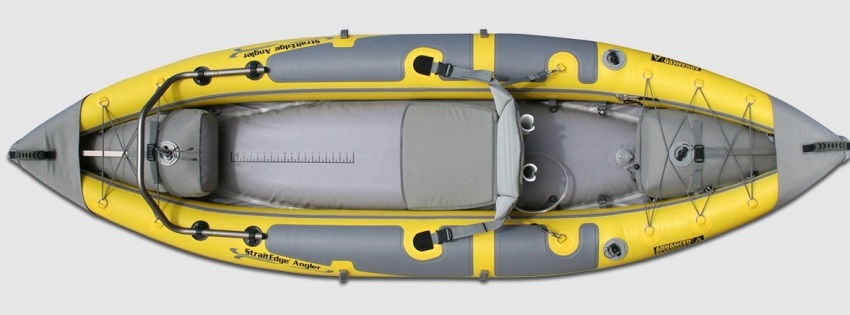
Length: 9’7” (294.6 cm)
Width: 35” (89 cm)
Weight: 41 lb (18.6 kg)
Capacity: 300 lb (136 kg)
Inflatable kayaks are often overlooked when it comes to river fishing. However, the Advanced Elements StraitEdge Angler is a great option for anyone who wants a boat that will easily navigate through rapids while keeping them upright and comfortable. The boat inflates to 9’8” (298.6 cm), which is perfect for maneuvering through rough waters in class I or II rapids.
It’s also very lightweight at just 41 lbs (18 kg) and you’ll have no problem handling this kayak in or out of the water to get to your destination. The StraitEdge Angler is only capable of holding 300 lbs (136 kg), which is usually enough for you to bring along just what you need and not much else.
You won’t be able to stand up and fish in the Advanced Elements StraitEdge Angler, but this boat does offer very comfortable seating with plenty of lower lumbar support and padding on the bottom. You’ll be able to fit your gear into two dry storage bags that can easily be secured at the bow and stern using bungee cords. This is a capable, budget-friendly option that is ideal for any river.
Wilderness Systems Ride 115

Length: 11’6” (351 cm)
Width: 33” (84 cm)
Weight: 76 lb (34 kg)
Capacity: 500 lb (227 kg)
Wilderness Systems went above and beyond in designing their Ride 115 for rough water rapids. This 11’6” (351 cm) boat is just compact enough to allow you to maneuver through river obstacles with little problems. The kayak offers a good amount of rocker to deal with changing water levels and keep you afloat in the roughest conditions.
One of the only downsides to the Ride 115 is that it’s a bit heavier than what you might want on a river at 76 lbs (34 kg). However, it does offer a whopping 500 lbs (227 kg) of total capacity that is more than enough for all your camping, fishing or hunting gear.
The seat sits very low to the deck and is moderately comfortable with decent back support. You’ll also find plenty of storage options with a large dry storage hatch on the bow, as well as an easy-to-reach dry hatch in the center of the cockpit. This kayak is a bit pricey, but is ideal for anglers who need to bring a heavy load of gear along on their trips.
Choosing a River Fishing Kayak: Factors to Consider
Maneuverability
Maneuverability is perhaps the most important quality a kayak can have for river use. The water can change from a slow pace to very fast-moving rapids in a matter of seconds and being able to quickly shift and change directions is crucial.
River rapids present a number of challenges in the form of rocks, turns, and other obstacles that can come up very quickly. When selecting a kayak that can deal with these kinds of challenges, it’s best to go with one that’s shorter and more compact.
A longer-bodied kayak is great for open water where you’ll be more concerned with picking up speed and maintaining momentum, but river rapids are often twisting and narrow. Most avid river anglers choose a kayak that’s no longer than 12’ in most cases.
Rocker is also a key component in a kayak that’s well-suited for rivers. The rocker simply refers to the level of curvature the kayak’s hull presents from bow to stern.
A kayak with a heavy amount of rocker will literally look more like the base of a rocking chair with a significant curve in its body. Kayaks with less rocker will essentially be more flat in hull design.
It’s important to have a boat with a good amount of rocker so you’ll be able to deal with the suddenly changing water levels in strong rapids. This high rocker profile lets you lean to one side and better deal with rapids as you move through the current.
Portability
River fishing often involves launching and landing on steeper, less accessible river banks. Low weight is important here. It is even more important on small rivers or in difficult rapids where you may have to drag the kayak over fallen trees or even portage it to avoid obstacles.
On most rivers, you will usually find yourself launching out of steeper, less accessible river banks. Getting down to these areas on foot is hard enough, but doing it with a kayak can be dangerous if you’re not careful.
It’s good to choose a more lightweight kayak when you’re planning to fish in rivers for this purpose. Having a lighter kayak is also better for when you encounter shallow water or impassable boulders or downed trees and you’re forced to exit the boat and drag it over these barriers.
Having a heavier kayak is often of no concern on lakes, but when it comes to rivers, it’s much better to have a lighter boat to increase your portability both in and out of the water.
RELATED: Best Kayak Carts, Wheels, and Trolleys: Never Drag Your Boat Again
Weight Capacity
When shopping for a short and lightweight kayak, it’s important to make sure the kayak can support your weight and the weight of all the gear you bring along. (mention the 70% rule).
River fishing presents a much greater degree of danger than any other body of water. Tipping your kayak over in a river can more easily result in injury or drowning due to the unpredictability of the current and the potential to get trapped underwater on rocks or other debris.
It’s very important that you are well-aware of the total weight capacity of the kayak you’re looking at. Take into account whether you plan to bring along extra gear for hunting or camping in addition to the usual gear you’ll need on a kayak such as paddles, PFDs, food, water, and other accessories.
You’re not likely to need the same heavy capacity in a river kayak as you might with one that’s better suited for lakes and coastal waters. There’s really no need for fish finders that require heavy batteries and mounts, so you can usually opt for a kayak with less total capacity.
Regardless of what the total capacity of the kayak is, you should never overload it with more than 70 percent of the rated capacity level. Be sure to take into account your own bodyweight, as well as the weight of any other gear you might bring along. If you load the boat with more than 70 percent of the total capacity, you’re putting yourself at a much greater risk of capsizing.
Comfort
A shorter hull and lower weight should not translate into less comfort. You’ll be on the water for hours, so it’s very important that you stay comfortable. A well-designed seat, good sitting position, and enough legroom are paramount.
There are no major differences in the comfort level you should expect out of a river kayak as opposed to one that’s better suited for flat water. You should try to select a kayak that doesn’t feature a high seat position to limit the chance that you’ll tip over, but that doesn’t mean you have to sacrifice much in the way of comfort.
The most ideal river kayak is one that lets you adjust the seat into either high or low positions. This lets you maintain just the right comfort level for calm or rough waters. If you anticipate going through stronger rapids, you’ll want a seat that is lower to the deck to lessen the chance of tipping over.
Stability
The kayak should be stable enough to fish comfortably, including standing up if you prefer.
In whitewater conditions, secondary stability becomes more important. Explain what primary and secondary stability mean, what is a chine.
Stability is always a major concern when it comes to fishing kayaks. It’s even more important on rivers due to the heightened risk of falling into the water, which is much more dangerous due to the current.
Hull designs are made with both primary and secondary stability. Primary stability comes from the center of the hull and makes the boat feel more steady without wobbling to one side or the other very easily.
Secondary stability refers to the kayak’s outer hull and its ability to prevent the boat from tipping over when you lean very far to one side or the other. A boat with high secondary stability might actually feel more ‘tippy’ and wobble back and forth more, which can be concerning for novice kayakers.
When it comes to river kayaks, a boat with more secondary stability is the better choice. A kayak with better secondary stability will be more responsive to the changing water levels around it, which lets you adjust and maneuver more quickly through rapids.
River kayaking is also best done with a boat that offers a more rounded chine. Harder chine refers to the sharper angles that the kayak has on its sides as it tapers down towards the center line. Having a more rounded chine allows your boat to better respond to the shifting water conditions and gives it more secondary stability.
Storage
It makes sense to go lighter when fishing rivers, but you still need enough room and storage features for your gear.
Having ample storage capacity on your river kayak is also key to meeting your needs. Keeping your boat as lightweight as possible is paramount to maintaining good stability and performance in and out of the water.
It’s important to find the right balance between storage capacity and making sure you carry only the gear you need without much extra. While you can usually load a kayak down for lake trips, river kayaking is much more serious in terms of planning and securing your belongings to the boat.
When river kayaking, always have all of your gear secured to the boat, inside or out, to be prepared to tip over. Make sure your kayak has enough dry storage to hold all your important items inside while letting you store other gear outside where it can be secured with bungee cables.
When it comes to storing your fishing rods, it’s always better to have them as close to the boat as possible instead of keeping them in vertical rod holders. You’ll want to avoid the potential for your rod to be caught on low-hanging branches or anything else as you traverse rivers and streams.
Dry storage is important. In-hull storage can also be useful on a small kayak
Make sure everything can be secured. Things can get out of control quickly on moving water, so plan for a swim and leash all your stuff.
If possible, opt for horizontal rod storage. On small rivers, you’ll often paddle and fish under low-hanging branches, which could damage your rods in vertical flush mount rod holders.
Sit-on-Top vs Sit-Inside for River Fishing
It’s no secret that sit-on-top kayaks are much more comfortable than sit-inside models due to their ample space and higher seat position. There are some significant differences between these two types of kayaks that should be considered when it comes to river fishing.
Sit-on-top kayaks offer you a bit more room and comfort than sit-inside versions. They also feature self-bailing scupper holes that automatically drain water out of the cockpit, as well as better overall stability that allows you to stand up while fishing. One main downside is that you have no protection from the water and will typically end up getting soaked when passing through rapids.
Sit-inside kayaks are usually preferred by boaters who traverse through rivers on pleasure trips. These kinds of kayaks can also prove to be quite useful for fishing, although you won’t be able to stand at any time. Sit-inside kayaks will keep you much more protected and dry when going through rough waters, which is a huge plus when you’re on rivers that have ice-cold waters.

